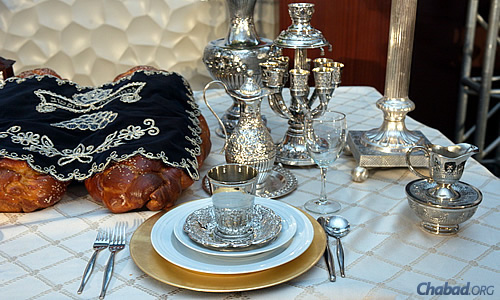Shabbat invitations are front-seat tickets for learning about traditional Jewish life. Newbies to Jewish observance dream of the day when they, too, will be able to host and inspire others. But it can be daunting to think of the abundance of dishes, the lavish table, and the deep Torah thoughts and Shabbat songs that one might be expected to share with their guests.
But that needn’t be the case. Shabbat has been welcomed and celebrated differently in different communities and cultures for more than 3,000 years, and you don’t have to be a Torah scholar or expert chef to host a Friday-night dinner or Saturday lunch.
Welcoming guests is a big mitzvah, and the fact that you’re doing so on Shabbat carries even greater weight. Expect that not everything is going to be perfect—there will be glitches and occasionally arguments and tears, power failures or ruined dishes. This is part of life. The attitude with which you meet these unpleasant occurrences is more important. Show you guests the beauty of the Shabbat, and that a Jew has a happy, grateful, flexible attitude.
Here are 10 tips to make having Shabbat guests easier.
1. The Food Doesn’t Need to Be Extravagant
While the Shabbat meal should be more lavish than the rest of the week, it doesn’t have to be a feast, and it doesn’t have to be cooked from scratch. The food on Shabbat is blessed with its own spice.
The story is told of Rabbi Judah the Prince, a great Torah sage who was friendly with Antoninus, the Roman emperor. Once the Roman Emperor had a Shabbat meal with Rabbi Judah and enjoyed it tremendously. On another occasion, not on Shabbat, the Emperor joined Rabbi Judah and noted that something was missing from the meal. Rabbi Judah answered him that what was missing was the spice of Shabbat.
You can cook the food, order it out, bring it from the kosher market, or have a potluck supper. Gefilte fish and chicken soup are not required items; any food that gives you pleasure (and, of course, is kosher) is fine. The only requirement is to have wine or grape juice and two rolls or loaves of bread to recite the blessings. The Shabbat table doesn’t have to be adorned with china and crystal, and there are many creative ways to make it special without overtaxing yourself.
2. Meaningful Conversation
Shabbat meals are meant to be accompanied by Torah thoughts and Shabbat songs to elevate Shabbat from the mundane and ensure that it’s of a more spiritual and positive nature. There are many Torah sites (like this one) that feature thoughts on the weekly Torah portionthat you can print out and read. You can also share stories of Divine Providence that have happened to you, expressions of gratitude for the blessings in your life, or inspiring stories. If you don’t know Shabbat songs, there are many inspiring ones in English. Chassidim sing niggunim, catchy melodies that don’t have words. You can even make up your own songs!
3. No Distractions
Explain to your guests in advance that one of the beauties of the Shabbat meal is that there are no distractions—no cell phones, no telephones, no tablets or other devices—just people spending quality time with each other. For someone new to the experience, this is amazing in and of itself. But because there are no distractions, make sure that everyone will be comfortable. Make sure there are enough places to sit, that there’s enough light without being too bright, that the temperature is comfortable, that there’s enough tissues and towels. We are not allowed to light a fire on Shabbat. While this refers to a physical fire, make sure there’s no emotional fire either—i.e., no conflict or anger on Shabbat.
4. Be Flexible
Don’t be so rigid that people have to sit in their seats for hours and feel that they can’t get up and stretch their legs or go sit on the couch, but do try to maintain some festive decorum so that the meal takes on a heightened importance. Take the median path. Young children shouldn’t feel that they have to sit at the table throughout the meal, so you might want to set up some (non-electronic) games or toys nearby for them to play with.
5. Make Every Guest Feel Important
Welcome and engage your guests in conversation, and ask them questions about their lives that they would feel comfortable sharing. Honoring others is a big mitzvah. People will remember more how you treated them than what food you served.
6. Dietary Requirements
Before planning your menu, ask your guests if they have any special dietary requirements—if they are gluten- or lactose-intolerant, vegan, vegetarian or allergic to anything. Make sure to tell your guests in advance the main foods you’ll be serving.
7. Dress Up
Dress like you are receiving a queen—the Shabbat queen—but also be comfortable so that you’re not itching for your guests to leave.
8. Explain the Basic Laws in Advance
Make sure your guests know the basic laws and decorum in advance, especially in areas where they may slip up. Have light-switch guards so they don’t accidentally turn off the lights in the bathroom, and tell them that if they want to bring anything, to do so before the start of Shabbat (for example, flowers can’t be placed in water once Shabbat starts).
9. Light Shabbat Candles
If your guests are coming before Shabbat, invite women and girls to light Shabbat candles with you. You can print out the candle-lighting blessings beforehand to make it easier for them.
10. Have Booklets for Blessings and Songs
Prepare enough booklets with the Birkat Hamazon, the “Grace After Meals,” with English translation or Hebrew transliteration. You can also prepare the hand-washing blessing and blessing over the bread. Don’t forget to explain what you’re doing and why; for example, after washing their hands, make sure your guests understand that they’re not allowed to speak until we take a piece of challah bread and eat it.
Shabbat Shalom! Enjoy your company!



